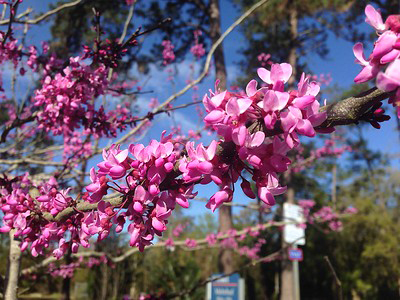Eastern Redbud
This native tree signals the start of spring in Florida

Eastern redbud is an attractive native tree with a range that stretches from Canada all the way down to Florida and into Mexico. It signals the start of spring with a striking floral display. Redbud’s rapid growth and small size make it an excellent choice for gardeners hoping to add color or fill an empty space in the landscape.
This species (Cercis canadensis) is a member of the botanical family Fabaceae, making it a close relative of beans, peas, peanuts, tamarind, and other legumes. The resemblance between redbud and its relatives seems slight until late summer, when the tree bears hundreds of bean pods. These pods aren’t commonly consumed, but redbud flowers are eaten raw, pickled, and fried. If redbud-blossom salad doesn’t sound like a treat to you, don’t worry; the bees, butterflies, and birds will enjoy the blooms for you.
Characteristics

Eastern redbud is a small- to medium-sized tree. Mature specimens can reach a height of 20 to 30 feet with a 25 foot spread. The crown is irregular and can be rounded or vase shaped, single- or multi-trunked, depending on the cultivar and pruning. It grows across the eastern half of the United States, from USDA Hardiness Zones 4 to 9A.
Redbud trees are frequently recognized by their blooms. In early spring clusters of small pink or white flowers open along still-bare branches. White (alba) cultivars tend to bloom about a week after the pink cultivars. In late summer, seed pods follow these floral displays. The pods are green, sometimes with a red tinge, and mature to a red-brown. The beans they contain provide food for birds.
Redbuds are also prized for their heart-shaped leaves and colorful foliage. These species are genetically biodiverse by nature; controlled breeding programs have been able to produce dozens of new forms. Many of these cultivars boast lime green, yellow, bronze, or burgundy leaves. The foliage of some will deepen to dark green by the end of summer. A few cultivars display yellow fall color, too, but the display is not consistent from year to year.
One of the most popular cultivars is ‘Forest Pansy’ which features purple-red spring foliage that fades to purple-green as the weather warms. ‘Flame Thrower’ has red-burgundy foliage that fades to yellow and green, giving it a multicolored look. ‘Hearts of Gold’ and ‘Rising Sun’ begin the year with yellow foliage and fade to green. ‘Ruby Falls’ and ‘Purple Leaf’ start purple. ‘Silver Cloud’ and ‘Whitewater’ have green leaves variegated with white. Finally, a couple of cultivars have notable blossoms; ‘Pink Pom Pom’ blooms with deep pink double flowers and ‘Pink Heartbreaker’ sports blooms with a touch of purple.
Maintenance and Care

Redbud trees can be planted in full sun or partial shade and generally require little care. Plant them on their own as specimen trees, or use them under a larger tree with a dappled canopy. The further south in the state they are planted, the more shade they require.
In general, these trees prefer sites with light, rich, moist soil, but are very adaptable. In Florida they thrive in sandy and alkaline soils, and along dry ridges or wet banks. Once established, most redbud cultivars are fairly drought tolerant but they do prefer some light irrigation in dry, hot weather. In areas too dry for Eastern redbud to thrive, C. canadensis var. texensis ‘Oklahoma’ and ‘Texas White’ are good substitutes.
Cercis canadensis is a short-lived tree and specimens older than thirty are rare. For this reason UF/IFAS does not suggest it for narrow roadsides or medians. It is appropriate for home and commercial landscapes where it makes a show-stopping specimen or understory planting.
To keep the structure of your redbud strong, prune to reduce the length of lateral branches. U-shaped crotches are evidence of good structure but remove V-shaped ones to prevent breakage and damage to the tree.

Part of the reason for redbud’s short lifespan is its poor resistance to disease and pests. Canker girdles stems and these diseased branches will require pruning. Leafspot and verticillium wilt can be a problem as well. Healthy trees with good structure and airflow will suffer less from fungal attacks. Scales, webworm, and borers are an issue occasionally as well.
Add redbud trees to your landscape by propagating from seed or by purchasing and transplanting young trees. Native nurseries typically collect seed from local populations to ensure optimal performance in your area. Containerized trees can be planted anytime of the year but young trees do best when transplanted in the spring or fall. As you would with any newly planted tree or shrub, water redbud transplants until they are established.
For more information on Eastern redbud, contact your county Extension office.

